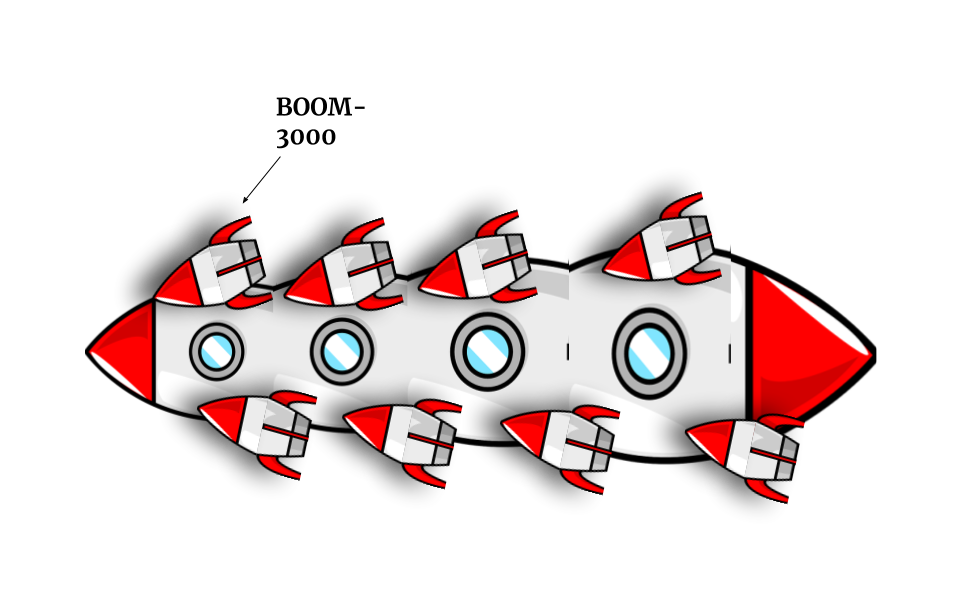The Case Of The Spinning Spaceship (Continued)
DISCLAIMER: There are spoilers for the first problem, The Case Of The Spinning Spaceship .

A thorough investigation of the above spaceship's dynamics leads to the conclusion that Physicist Pauto's hypothesis on the cause of the spaceship's rotation is correct: the moment is, indeed, nonzero.
"Now, this is all very good, finding the solution to the issue and so, blah blah blah," says Engineer Eevis, annoyed. "However, I fear your results it shall not help."
"And why is this?" asks Pauto.
"You see, the Federation wishes for the spaceship's engines to be placed such that the horizontal component of distance between consecutive engines, counting pairs on either side, is equal. Something about abstract art and causing an impression."
"Well, that's a minus." Pauto frowns. "Unless... Yes, there is a possible way to arrange the engines such that the moment is , while respecting the Federation's wish!"
"Is there one way?" asks Eevis.
"No," Pauto replies. "There's more."
In how many ways can the engines be arranged, taking into account the Federation's wish? Ignore trivial arrangements such as reflections.
Details and assumptions
-
Each engine is equally distanced from the engine directly in front and/or behind, including pairs on opposite sides, and the centerline of the ship.
-
The angle formed by the ship's centreline and the engines is equivalent for all engines, and is greater than 0.
-
The first and last engines are placed directly on the bow and stern, respectively.
-
Each engine provides exactly the same amount of thrust.
-
The BOOM - efficiently converts all of its energy into thrust in the direction of the engines. (I know this doesn't happen in real life, but assume that the discrepancy is so small that no feasible instrument could effectively measure it.)
-
The ship has infinitely many degrees of rotational symmetry around its central axis, from bow to stern.
The answer is 4.
This section requires Javascript.
You are seeing this because something didn't load right. We suggest you, (a) try
refreshing the page, (b) enabling javascript if it is disabled on your browser and,
finally, (c)
loading the
non-javascript version of this page
. We're sorry about the hassle.
In my previous solution to The Case Of The Spinning Spaceship , I explained Archimede's Law Of The Lever :
We then calculated the moment for the spaceship:
m a = 4 d a − 4 d a = 0
m b = 0 + d e n g i n e b − 2 d e n g i n e b + 3 d e n g i n e b − 4 d e n g i n e b + 5 d e n g i n e b − 6 d e n g i n e b + 7 d e n g i n e b = 4 d e n g i n e b
In the second equation, d e n g i n e is equal to the distance between consecutive engines, and n d e n g i n e is the distance between the n th oar and the stern, which has position d e n g i n e = 0 .
We must now solve for when the moment is 0 . As the distance d remains unchanged, the first equation is still equal to 0 . This leaves us with the second equation, which, when the left-right position of the engines is unknown and the moment is assumed to be 0 , takes the form:
m b = 0 = 0 ± d e n g i n e b ± 2 d e n g i n e b ± 3 d e n g i n e b ± 4 d e n g i n e b ± 5 d e n g i n e b ± 6 d e n g i n e b ± 7 d e n g i n e b
Dividing both sides by d b gives:
0 ± 1 ± 2 ± 3 ± 4 ± 5 ± 6 ± 7 = 0
Now, the sum of [ 0 , 1 , 2 , 3 , 4 , 5 , 6 , 7 ] is 2 8 , which means that the sum of the moments of one side of engines must be 1 4 . Thus, this question is equivalent to separating the numbers [ 0 , 1 , 2 , 3 , 4 , 5 , 6 , 7 ] into two sets with sum 1 4 .
Begin with the set containing 0. If it also contains 1 , then the other two numbers must be [ 6 , 7 ] . If it contains 2 but not 1 , then the other two numbers are either [ 4 , 6 ] or [ 5 , 7 ] . If it contains 3 but not 2 and/or 1 , then the other two numbers must be [ 5 , 6 ] . By similar reasoning, we cannot find a similar set for 4 , 5 , 6 , 7 , 8 . Thus, the 4 sets [ 0 , 1 , 6 , 7 ; 2 , 3 , 4 , 5 ] , [ 0 , 2 , 4 , 6 ; 1 , 3 , 5 , 7 ] , [ 0 , 2 , 5 , 7 ; 1 , 3 , 4 , 6 ] , and [ 0 , 3 , 5 , 6 ; 1 , 2 , 4 , 7 ] are the only possible arrangements.